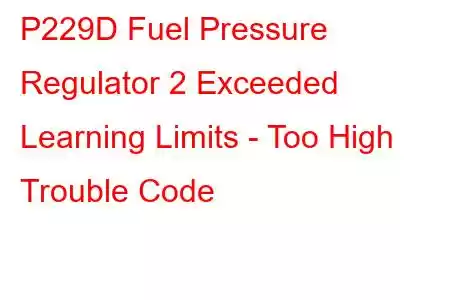P229D Fuel Pressure Regulator 2 Exceeded Control Limits - Too High
OBD-II Trouble Code Technical Description
Fuel Pressure Regulator 2 Exceeded Control Limits - Too High
What does P229D mean?
This diagnostic trouble code (DTC) is a generic powertrain code and applies to many OBD-II vehicles (1996-newer). That may include but is not limited to vehicles from Volkswagen, GMC, Chevrolet, Cadillac, Ford, BMW, etc. Although generic, the exact repair steps may vary depending on year, make, model and powertrain configuration.
In my personal experience diagnosing a P229D, it has applied exclusively to diesel powered vehicles. It has also meant that the powertrain control module (PCM) had detected an excessive degree of fuel pressure sensor voltage in the electronic fuel pressure sensor/regulator during periods when the PCM attempted to carryout adaptive learning (or relearning) strategy.
The regulator in question had been designated with a 2. Systems which utilize multiple electronic fuel pressure regulators often use a numerical designation. The 2 may also refer to a certain bank of the engine. Check manufacturer's specifications for the vehicle in question. High pressure diesel fuel injection systems should be serviced by qualified personnel ONLY.
The PCM (or some type of integrated diesel controller) monitors/controls the electronic fuel pressure regulator. Using input data from the fuel pressure sensor (located in the fuel injector rail), the PCM adjusts pressure regulator voltage constantly when the engine is running. Battery voltage and ground signals are used to control a servo motor (in the fuel pressure regulator) which actuates a valve used to ensure that the desired level of fuel pressure may be achieved for any given situation.
When voltage is increased at the electronic fuel pressure regulator servo motor, a valve is opened, and fuel pressure is increased. Decreased voltage at the servo causes the valve to close and fuel pressure is decreased. The fuel pressure regulator and fuel pressure sensor are most frequently integrated into a single housing (with one electrical connector) but may also be separate components.
If actual fuel pressure regulator 2 control circuit voltage (pressure) which is not within a certain parameter during a learning session, a P229D will be stored and a malfunction indicator lamp (MIL) may be illuminated.
A typical fuel pressure regulator:
What is the severity of this DTC?
Since insufficient/excessive fuel pressure may cause internal engine and catalytic converter damage and lead to various drivability issues, a code P229D should be categorized as severe.
What are some of the symptoms of the code?
Symptoms of a P229D trouble code may include:
No start condition Engine misfire codes and idle control codes may also accompany a P229D Diminished fuel efficiency Delayed startup when the engine is cool Black smoke from the exhaust systemWhat are some of the common causes of the code?
Causes for this code may include:
Engine not timed correctly Low engine oil pressure/level Faulty fuel pressure sensor Defective fuel pressure regulator Shorted or open wiring and/or connectors in the fuel pressure regulator control circuit Bad PCM or a PCM programming errorWhat are some P229D troubleshooting steps?
You will need a diagnostic scanner, a digital volt/ohmmeter (DVOM), and a source of reliable vehicle information in order to accurately diagnose a code P229D.
You may save yourself time by searching for technical service bulletins (TSB) that replicate the code stored, vehicle (year, make, model, and engine), and symptoms exhibited. This information may be found in your vehicle information source. If you find the right TSB, it could yield a speedy solution to your diagnosis.
After you connect the scanner to the vehicle diagnostic p
Read: 19


